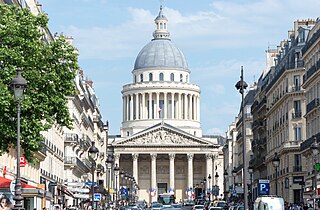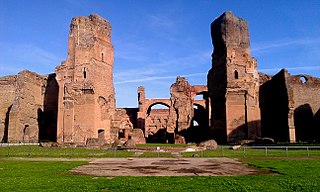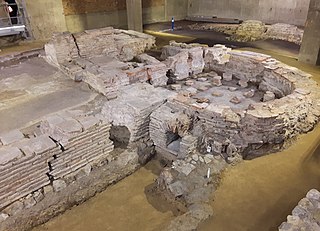
The Thermes de Cluny are the ruins of Gallo-Roman thermal baths lying in the heart of Paris' 5th arrondissement, and which are partly subsumed into the Musée national du Moyen Âge - Thermes et hôtel de Cluny.
Contents


The Thermes de Cluny are the ruins of Gallo-Roman thermal baths lying in the heart of Paris' 5th arrondissement, and which are partly subsumed into the Musée national du Moyen Âge - Thermes et hôtel de Cluny.

The present bath ruins constitute about one-third of a massive bath complex that is believed to have been constructed around the beginning of the 3rd century. The best preserved room is the frigidarium , with intact architectural elements such as Gallo-Roman vaults, ribs and consoles, and fragments of original decorative wall painting and mosaics.
It is believed that the bath complex was built by the influential guild of boatmen of 3rd-century Roman Paris or Lutetia , as the consoles on which the barrel ribs rest are carved in the shape of ships' prows. Like all Roman Baths, these baths were freely open to the public, and were meant to be, at least partially, a means of romanizing the ancient Gauls. [1] As the baths lay across the Seine river on the Left Bank and were unprotected by defensive fortifications, they were easy prey to roving barbarian groups, who apparently destroyed the bath complex sometime at the end of the 3rd century.
The bath complex is partly an archaeological site, and has partly been incorporated into the Musée national du Moyen Age (or Musée de Cluny). It is the occasional repository for historic stonework or masonry found from time to time in Paris. The spectacular frigidarium is entirely incorporated within the museum and houses the Pilier des Nautes (Pillar of the Boatmen). Although somewhat obscured by renovations and reuse over the past two thousand years, several other rooms from the bath complex are also incorporated into the museum, notably the gymnasium, which now forms part of gallery 9 (Gallery of French Kings and sculptures from Notre Dame that were taken down during the iconoclasm of the French Revolution). The caldarium (hot water room) and the tepidarium (warm water room) are both still present as ruins outside the Musée and on the museum's grounds.

The 5th arrondissement of Paris is one of the 20 arrondissements of the capital city of France. In spoken French, this arrondissement is referred to as le cinquième.

The Musée de Cluny, officially Musée de Cluny-Musée National du Moyen Âge, is a museum of medieval art in Paris. It is located in the 5th arrondissement of Paris, bordered by square Samuel-Paty to the south, boulevard Saint-Michel to the west, boulevard Saint-Germain to the north, and rue Saint-Jacques to the east.

In ancient Rome, thermae and balneae were facilities for bathing. Thermae usually refers to the large imperial bath complexes, while balneae were smaller-scale facilities, public or private, that existed in great numbers throughout Rome.

The Baths of Caracalla in Rome, Italy, were the city's second largest Roman public baths, or thermae, after the Baths of Diocletian. The baths were likely built between AD 212 and 216/217, during the reigns of emperors Septimius Severus and Caracalla. They were in operation until the 530s and then fell into disuse and ruin.

Lutetia, also known as Lutecia and Lutetia Parisiorum, was a Gallo–Roman town and the predecessor of modern-day Paris. Traces of an earlier Neolithic settlement have been found nearby, and a larger settlement was established around the middle of the third century BC by the Parisii, a Gallic tribe. The site was an important crossing point of the Seine, the intersection of land and water trade routes.

The Baths of Diocletian were public baths in ancient Rome. Named after emperor Diocletian and built from AD 298 to 306, they were the largest of the imperial baths. The project was originally commissioned by Maximian upon his return to Rome in the autumn of 298 and was continued after his and Diocletian's abdication under Constantius, father of Constantine.

The Baths of Titus or Thermae Titi were public baths (Thermae) built in 81 AD at Rome, by Roman emperor Titus. The baths sat at the base of the Esquiline Hill, an area of parkland and luxury estates which had been taken over by Nero for his Golden House or Domus Aurea. Titus' baths were built in haste, possibly by converting an existing or partly built bathing complex belonging to the reviled Domus Aurea. They were not particularly extensive, and the much larger Baths of Trajan were built immediately adjacent to them at the start of the next century.
The Pillar of the Boatmen is a monumental Roman column erected in Lutetia in honour of Jupiter by the guild of boatmen in the 1st century AD. It is the oldest monument in Paris and is one of the earliest pieces of representational Gallo-Roman art to carry a written inscription.

Cluny–La Sorbonne is a station on Line 10 of the Paris Métro. Located in the 5th arrondissement, it serves the Latin Quarter on the Rive Gauche. The station is connected to the Saint-Michel–Notre-Dame on RER B and RER C. In 2013, the station was used by 2,509,657 passengers, making it the 219th busiest out of 302 on the Métro network.

The Welwyn Roman Baths are a Roman ruin preserved under the A1(M) just north of modern-day Welwyn Garden City, Hertfordshire, England. The baths were a small part of the Dicket Mead villa, which was originally built in the 3rd century AD.

Montoulieu-Saint-Bernard is a commune in the Haute-Garonne department of southwestern France.

The Roman Baths of Ankara are the ruined remains of an ancient Roman bath complex in Ankara, Turkey, which were uncovered by excavations carried out in 1937–1944, and have subsequently been opened to the public as an open-air museum.

Billingsgate Roman House and Baths is an archaeological site in Londinium. The best preserved parts of the house are a bath with hypocausts. The ruins were discovered in 1848 while the Coal Exchange was built on the site. The remains were preserved and were visible in the cellar of the building. In 1967 to 1970, the Coal Exchange was replaced by another building and the Lower Thames Street was enlarged. Further excavations were made at the site and the remains were incorporated into the cellar of the new building, but were not open to the public.

The Roman Thermae are a complex of Ancient Roman baths (thermae) in the Black Sea port city of Varna in northeastern Bulgaria. The Roman Thermae are situated in the southeastern part of the modern city, which under the Roman Empire was known as Odessus. The baths were constructed in the late 2nd century AD and rank as the fourth-largest preserved Roman thermae in Europe and the largest in the Balkans.

The Roman-Gaul Baths of Entrammes is a complex of Gallo-Roman thermal baths (thermae) in Entrammes, Mayenne, France. The baths were partially incorporated into a church with the hypocaust surviving below the new structure. The remains were discovered in 1987.

The Aïn Doura Baths are a series of Roman-era ruins located in Dougga, Tunisia. The site contains ruins from a Roman bath dating to the 4th century, and is considered an important archaeological heritage site by the National Heritage Institute of Tunisia.

Xavier Dectot, born on June 8, 1973 in Pithiviers, is a French museum curator and art historian.

Alexandre-Albert Lenoir was a French art historian, archaeologist, and writer; best known for creating what is now known as the Musée de Cluny.

The Jublains archeological site is a cluster of ruins, mostly dating back to Ancient Rome, in the current French commune of Jublains in the département of Mayenne in the Pays de la Loire.
{{cite web}}: CS1 maint: archived copy as title (link)